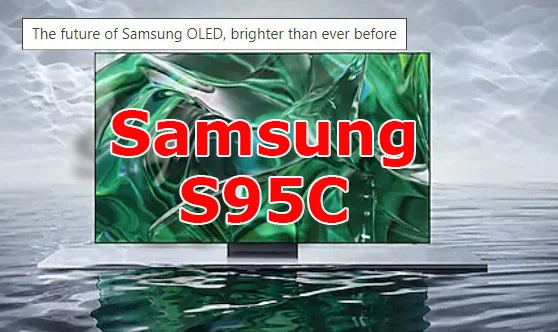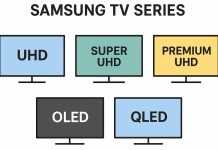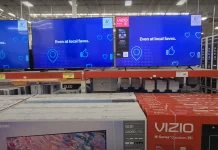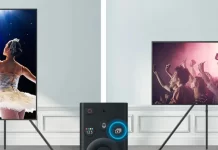Samsung has made significant changes to its OLED TV lineup, moving from the 2022 models to the 2023 series. One notable development was the completion of the large OLED display production line, allowing for the release of 77-inch panels. The first model with this new size was the 77S95C, officially labeled QN77S95CAFXZA in the US and Canadian markets, in Europe it is the QE77S95C. Below, we’ll review key aspects of the 77S95C and answer questions that potential buyers may have.
Design and build: Thin screen with a single connectivity unit
The 77S95C OLED TV has a two-part configuration: an ultra-thin screen and a separate One Connect unit that houses the TV’s computing components and ports. Samsung promotes this configuration as practical, emphasizing its role in achieving an ultra-thin screen profile. The One Connect unit is attached to a stand on the back of the TV, keeping the device compact. However, for those who value functionality over aesthetics, this design poses problems, especially when wall mounting.
The TV uses a VESA 400×400 mount for wall mounting, but the placement of the One Connect unit requires additional planning. Despite these challenges, a separate control unit offers the important advantage of simplifying repairs. In the event of a malfunction, the One Connect unit can be replaced yourself, avoiding the inconvenience of transporting the entire TV to a service center.
Brightness Improvement: Marketing vs. Reality
Samsung claims that the 77S95C’s screen is 30% brighter than its 2022 counterparts. Some reports put the peak brightness at 2,000 nits, but such numbers are skeptical. Peak brightness is usually measured under extreme conditions, such as displaying a white square with maximum brightness and contrast, which doesn’t correspond to real-world viewing scenarios.
Unfortunately, Samsung doesn’t cite typical brightness levels – a more relevant parameter for everyday use. The claimed brightness boost is attributed to quantum dot materials, which are ultra-pure substances that allow certain colors to pass through with minimal distortion. Although quantum dots improve color accuracy, their role in significantly increasing brightness is debatable. Thus, the brightness improvement may be more subtle than advertised.
Computing power: a “neuro-quantum processor”
Samsung’s marketing emphasizes the presence of a “neuro-quantum processor” in the S95C, but this is largely branding. In reality, the processor is a standard TV-adapted processor that supports parallel computing for efficient video stream processing. While these processors are adequate to deliver a smooth picture, their capabilities are more modest than those of today’s smartphones.
Historically, Korean TV manufacturers, including Samsung, do not disclose the specific models of processors used in their TVs. These are often off-the-shelf components from companies like MediaTek. For a TV, the main role of the processor is to provide OS and video processing.
S95B vs S95C Tech Specs
| Category | Feature | S95B (2022) | S95C (2023) |
|---|---|---|---|
| Screen | Screen Size | 55, 65 | 55, 65, 77 |
| Style | Flat Panel | Flat Panel | |
| Resolution | 3,840 x 2,160 | 3,840 x 2,160 | |
| Screen Bit | 10-bit | 10-bit | |
| Screen Type | QD+OLED | QD+OLED | |
| Screen Technology | OLED | OLED | |
| Backlighting | Self-luminous pixels | Self-luminous pixels | |
| Dimming Technology | Pixel-level | Pixel-level | |
| Stand Type (Color) | Blade Stand | Slim OC Stand | |
| Bezel Width | 4 Bezel-less | 4 Bezel-less | |
| Video | Motion Rate | – | – |
| Refresh Rate | 120Hz | 120Hz (Up to 144Hz) | |
| Color | 100% Colour Volume with Quantum Dot | Perceptional Color Mapping | |
| Contrast | Self-illuminating pixels | Self-illuminating pixels | |
| HDR (High-Dynamic Range) | Quantum HDR OLED | Quantum HDR OLED+ | |
| Picture Engine | Neo Quantum Processor 4K | Neural Quantum Processor 4K | |
| Film Mode | Yes | Yes | |
| HLG (Hybrid Log Gamma) | Yes | Yes | |
| Motion Technology | Motion Xcelerator Turbo+ | Motion Xcelerator Turbo Pro | |
| Anti-Reflection | Yes | Yes | |
| Audio | Dolby | MS12 5.1ch | MS12 5.1ch |
| Dolby Atmos | Yes | Yes | |
| Sound Output | 60W | 70W | |
| Woofer | Yes | Yes | |
| Speaker Type | 2.2.2 CH | 4.2.2 CH | |
| Object Tracking Sound | Yes | Yes | |
| Q-Symphony | Yes (only soundbar) | Yes (only soundbar) | |
| Multiroom Link | Yes | Yes | |
| Smart Features | Operating System (OS) | Tizen 6.5 | Tizen 7.0 |
| Wi-Fi | Yes (WiFi5) | Yes (WiFi5) | |
| Bluetooth | Yes (ver.5.2) | Yes (ver.5.2) | |
| SmartThings App Support | Yes | Yes | |
| Voice Assistants | Google Assistant, Alexa | Google Assistant, Alexa | |
| Inputs & Outputs | HDMI Ports | 4 (ver 2.1) | 4 (ver 2.1) |
| USB Ports | 2 | 3 | |
| Ethernet | Yes | Yes | |
| One Connect | No | Yes (77-inch model only) | |
| Accessories | Remote Control | TM2280 (solar) | TM2360E (solar) |
When examining the detailed technical specifications, the differences between these TV models are minimal. However, one noteworthy enhancement stands out: the increased brightness. This improvement is particularly significant, as OLED technology has historically struggled with lower brightness levels. If Samsung could elevate OLED brightness to match that of QLED displays, it would be a game-changer. Additionally, the introduction of the updated Tizen OS 7.0 in 2023 is worth mentioning. Beyond these advancements, the remaining technical specifications remain largely unchanged.






